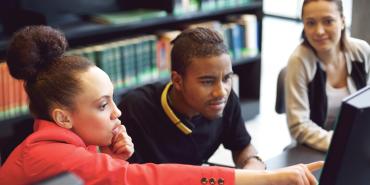Since 2022, an interdisciplinary team of researchers from the University of Washington, the University of Texas at Austin, Seattle Central College, and the Black Brilliance Research Project has been collaborating on Co-Designing for Trust, a multiyear grant provided by the National Science Foundation to mitigate the impact of misinformation—particularly on Black and rural communities. Given the Trump administration’s agenda, it’s tragic but unsurprising that the grant’s funding was terminated on April 25, 2025. The team received an email from the National Science Foundation stating, “The agency has determined that termination of certain awards is necessary because they are not in alignment with current NSF priorities.”
It’s tragic not for the faculty and staff involved, though many of us are frustrated and now facing hardships, but for the students. At Seattle Central College, we had several teams of students engaged in participatory research—they were members of the research team developing and refining community-based approaches to help people avoid falling victim to falsehoods. The unique composition of our research team led to profound new community solutions, grounded in real experience, to combat mis- and disinformation.
Since Seattle Central College is a community college, our focus has been workforce education around mis- and disinformation (with misinformation being unintentionally false and disinformation being designed to mislead). We worked with cohorts of students in English and English as a second language classes and with students in the Bachelor of Applied Behavioral Sciences and Bachelor of Allied Health programs for a couple of years to learn from them what types of mis- and disinformation they dealt with in their workplaces and communities. We talked to them as trusted community members and considered what their professional roles and responsibilities would be once they completed their education.
For example, one student in a healthcare program said that a patient came to the emergency department with a severe burn exacerbated by a “remedy” they’d found online. The student wanted to discuss examples of health misinformation and learn how to communicate with patients to gain trust in high-stakes situations. Another student relayed that their workplace had an anti-union disinformation campaign; they wanted help understanding it and talking to their colleagues. As a trans person, another student shared disinformation circulating about their community and wanted to know how to counteract harmful and potentially dangerous claims.
Once we had gathered these and many other examples, we developed case studies and engaged students in determining how to handle them. We started with basic questions: “Who trusts you? How do you build trust?” Then we considered strategies to think critically, counteract false information, and create a healthier information environment. Actually having these conversations in your workplace or community is hard, so we also talked through responsibilities. We asked, “As a friend, coworker, or neighbor of people who are promoting mis- or disinformation, what’s your role? What responsibilities do you have?” In our discussions of the case studies, it became clear that with our highly polarized environment, being able to understand your position, respond to falsehoods, and have conversations—even without coming to agreement—is helpful. It is healthy for our democracy to keep lines of communication open in respectful, evidence-based ways. That can cut through a lot of nasty mischaracterization of people and reduce polarization.
As much as we value the content we have been creating, we also value the opportunities this grant gave our students. The cohorts we worked with devoted many hours to this project, and they were paid as researchers. Our work depended on the examples they provided and the effort they put into working through how to handle these challenging situations. When the grant was terminated, we had already developed 13 lesson plans and were preparing to pay new cohorts of students to give us feedback on the lessons. We will complete the curriculum, but now we’ll have to do it over time by piloting and refining the lesson plans as we teach classes. What could have been done in six months may instead take years—and the students we would have been paying will have to volunteer their time and thoughts. Most of our students are struggling financially, so the extra money they earned through this project made a real difference. In addition, the grant would have funded a website for this material; now we’ll have to be creative to determine how to share our Community Power Tools for Combating Mis- and Disinformation Toolkit with educators and community leaders across the country.*
It is ironic, to say the least, that we have been forced to stop working with our students, who are trusted community members, on a grant that is centered on community trust and community-based strategies. Our students understand what has happened, but to be trustworthy community members, we are determined to finish this work on our own time and with our own resources, so that their work can serve future students and community members, as intended.
The feedback we have gotten from students as we try out and refine our lessons has been overwhelmingly positive. Our materials resonate with students because they are based on their peers’ real experiences—and they are using what they learn about promoting a healthy information environment in real time. That’s another reason we will continue this work.
The authors are faculty librarians and active members of their respective AFT locals.
*For more information about the toolkit, contact althea.lazzaro@seattlecolleges.edu. (return to article)
[Photo by jacoblund / iStock / Getty Images Plus]

